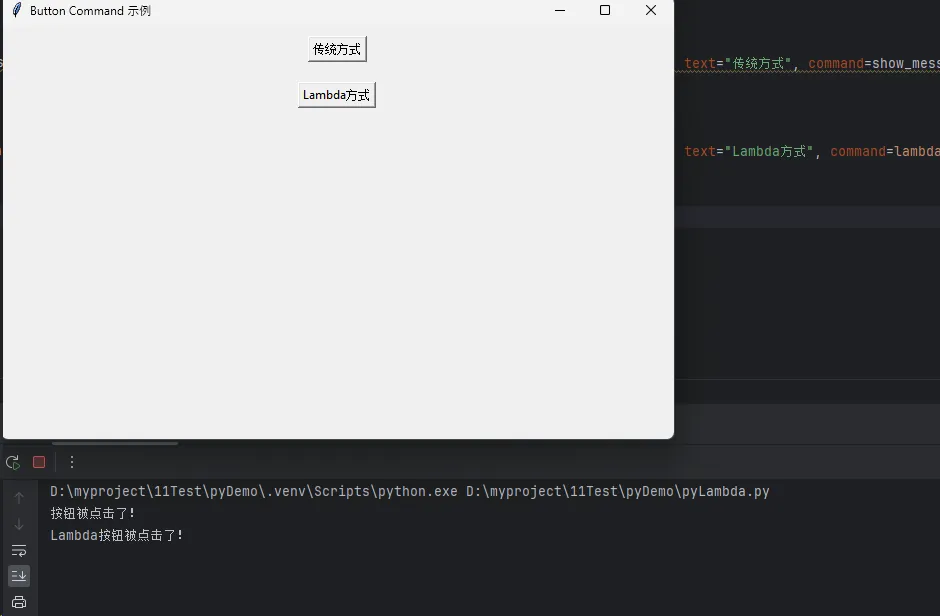目录
在Python开发中,你是否遇到过这样的困扰:为了一个简单的计算功能,却要定义一个完整的函数?或者在使用map()、filter()等高阶函数时,总是需要额外定义辅助函数?这些看似微不足道的问题,却会让代码变得冗长和难以维护。
Lambda表达式就是解决这些问题的利器!作为Python中的"匿名函数",它能让你用一行代码完成原本需要多行的功能定义,让代码更加简洁、优雅。无论你是在进行数据处理、GUI事件绑定,还是函数式编程,掌握Lambda表达式都能显著提升你的开发效率。
本文将从实际问题出发,通过丰富的代码实战,带你深入理解Lambda表达式的核心概念、使用场景和最佳实践,让你的Python编程技巧更上一层楼!
🔍 什么是Lambda表达式?
Lambda表达式是Python中定义匿名函数的一种简洁方式。它允许你在需要函数的地方直接定义简单的函数,而无需使用def关键字正式声明。
📝 基本语法
Pythonlambda 参数: 表达式
让我们通过对比来理解Lambda的威力:
Python# 传统函数定义
def square(x):
return x ** 2
# Lambda表达式
square_lambda = lambda x: x ** 2
# 使用效果完全相同
print(square(5)) # 输出: 25
print(square_lambda(5)) # 输出: 25

🎯 Lambda表达式的核心优势
✨ 代码简洁性
问题场景:需要对列表中的每个元素进行简单运算
Python# 传统方式:需要定义额外函数
def add_ten(x):
return x + 10
numbers = [1, 2, 3, 4, 5]
result = list(map(add_ten, numbers))
# Lambda方式:一行搞定
numbers = [1, 2, 3, 4, 5]
result = list(map(lambda x: x + 10, numbers))
print(result) # [11, 12, 13, 14, 15]

⚡ 即用即定义
问题场景:事件处理或回调函数
Pythonimport tkinter as tk
root = tk.Tk()
root.title("Button Command 示例")
# 传统方式:定义函数
def show_message():
print("按钮被点击了!")
button1 = tk.Button(root, text="传统方式", command=show_message)
button1.pack(pady=10)
# Lambda方式:匿名函数
button2 = tk.Button(root, text="Lambda方式", command=lambda: print("Lambda按钮被点击了!"))
button2.pack(pady=10)
root.mainloop()

💡 Lambda表达式的实战应用
🔥 数据处理与筛选
筛选偶数
Pythonnumbers = [1, 2, 3, 4, 5, 6, 7, 8, 9, 10]
# 使用filter + lambda筛选偶数
even_numbers = list(filter(lambda x: x % 2 == 0, numbers))
print(f"偶数: {even_numbers}") # [2, 4, 6, 8, 10]
# 筛选大于5的数
greater_than_five = list(filter(lambda x: x > 5, numbers))
print(f"大于5: {greater_than_five}") # [6, 7, 8, 9, 10]

数据转换
Python# 温度转换:摄氏度转华氏度
celsius = [0, 20, 30, 40]
fahrenheit = list(map(lambda c: c * 9/5 + 32, celsius))
print(f"华氏度: {fahrenheit}")
# 字符串处理
names = ["alice", "bob", "charlie"]
capitalized = list(map(lambda name: name.capitalize(), names))
print(f"首字母大写: {capitalized}")

📊 排序和数据分析
复杂排序
Python# 学生信息排序
students = [
{"name": "张三", "age": 20, "score": 85},
{"name": "李四", "age": 19, "score": 92},
{"name": "王五", "age": 21, "score": 78}
]
# 按成绩排序
sorted_by_score = sorted(students, key=lambda student: student["score"], reverse=True)
print("按成绩排序:")
for student in sorted_by_score:
print(f"{student['name']}: {student['score']}分")
# 按年龄排序
sorted_by_age = sorted(students, key=lambda student: student["age"])
print("\n按年龄排序:")
for student in sorted_by_age:
print(f"{student['name']}: {student['age']}岁")

数据聚合
Pythonfrom functools import reduce
# 计算列表元素乘积
numbers = [1, 2, 3, 4, 5]
product = reduce(lambda x, y: x * y, numbers)
print(f"乘积: {product}") # 120
# 找出最大值
max_value = reduce(lambda x, y: x if x > y else y, numbers)
print(f"最大值: {max_value}") # 5

🎮 条件判断与分支
Python# 根据条件选择操作
def process_data(value, operation):
operations = {
'square': lambda x: x ** 2,
'cube': lambda x: x ** 3,
'double': lambda x: x * 2,
'half': lambda x: x / 2
}
return operations.get(operation, lambda x: x)(value)
print(process_data(4, 'square')) # 16
print(process_data(3, 'cube')) # 27
print(process_data(10, 'half')) # 5.0
🔧 Windows应用开发中的实际应用
文件处理
Pythonimport os
from pathlib import Path
# 筛选特定类型的文件
def get_files_by_extension(directory, extensions):
all_files = os.listdir(directory)
return list(filter(lambda f: any(f.endswith(ext) for ext in extensions), all_files))
# 使用示例
current_dir = "."
python_files = get_files_by_extension(current_dir, ['.py', '.pyw'])
print(f"Python文件: {python_files}")

配置文件处理
Python# 处理配置参数
config_raw = "key1=value1;key2=value2;key3=value3"
# 使用Lambda解析配置
config_dict = dict(map(lambda item: item.split('='),
filter(lambda x: '=' in x, config_raw.split(';'))))
print(f"配置字典: {config_dict}")

⚠️ Lambda使用注意事项
🚫 避免的陷阱
过度复杂化
Python# ❌ 不推荐:Lambda过于复杂
complex_lambda = lambda x: x ** 2 if x > 0 else -x ** 2 if x < 0 else 0
# ✅ 推荐:使用常规函数
def handle_number(x):
if x > 0:
return x ** 2
elif x < 0:
return -x ** 2
else:
return 0
变量捕获问题
Python# ❌ 常见错误:闭包变量捕获
functions = []
for i in range(5):
functions.append(lambda x: x + i) # i的值会是最后一次循环的值
# 所有lambda都会使用i=4
for func in functions:
print(func(10)) # 都输出14
# ✅ 正确做法:使用默认参数
functions = []
for i in range(5):
functions.append(lambda x, i=i: x + i)
for func in functions:
print(func(10)) # 输出10, 11, 12, 13, 14
💡 最佳实践建议
- 保持简单:Lambda适合单行表达式,复杂逻辑请使用def函数
- 提高可读性:为复杂的Lambda添加注释
- 避免副作用:Lambda应该是纯函数,不要修改外部变量
- 合理命名:如果Lambda会被多次使用,考虑赋值给有意义的变量名
🎯 总结
Lambda表达式作为Python编程技巧中的重要工具,为我们提供了编写简洁、优雅代码的能力。通过本文的学习,我们掌握了三个核心要点:
- 语法简洁性:Lambda让简单函数的定义变得轻松,特别适合与
map()、filter()、sorted()等高阶函数配合使用 - 实战应用广泛:从数据处理、事件绑定到条件判断,Lambda在实际Python开发和上位机开发中都有广泛应用
- 合理使用原则:保持简单、避免过度复杂化,在提升代码简洁性的同时确保可读性
掌握Lambda表达式不仅能让你的代码更加Pythonic,更能在数据分析、GUI开发等实际项目中显著提升开发效率。记住,最好的编程技巧不是炫技,而是在合适的场景下选择最合适的工具!
想了解更多Python编程技巧?关注我们,获取更多实用的开发经验分享!
本文作者:技术老小子
本文链接:
版权声明:本博客所有文章除特别声明外,均采用 BY-NC-SA 许可协议。转载请注明出处!
目录